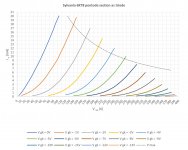The 6KT8 is a wee 9-pin triode-pentode. Has anyone traced or measured the pentode section (specified as gm=10mS for Vak=Vs=125V etc etc) when triode-connected?
In the absence of measured triode curves, I will probably rely on those for the 6BN11 - the specifications are similar - but would appreciate real 6KT8 curves if they are about.
In the absence of measured triode curves, I will probably rely on those for the 6BN11 - the specifications are similar - but would appreciate real 6KT8 curves if they are about.
Thank you, Smoking Amp! I have taken your oscillograph, converted the traces to data points and loaded them into an excel spreadsheet (.xlsm fille attached).
At first blush, operating the 6KT8 pentode as a triode with Vak=145V, Vgk=-2V and ia=10mA gives:
I have used an abused the 6KT8 as a mu-stage with the triode section loaded by the pentode. It is a bit of a juggle to get good results while respecting the heater-cathode voltage limits 🙁 I am now thinking of the 6KT8 as a candidate for a triode voltage stage followed by a cathodyne phase splitter using the pentode strapped as a triode. Or vice versa 🙂
At first blush, operating the 6KT8 pentode as a triode with Vak=145V, Vgk=-2V and ia=10mA gives:
- fairly constant mu=-41 for +-1.5V swing; though
- rp will swing from 4.4kOhm @ Vgk =0V up to about 5.5kOhm at Vgk=-4V;
- with a corresponding swing in gm from 9.6 mS @ Vgk=0V down to about 7.7mS at Vgk=-4V
I have used an abused the 6KT8 as a mu-stage with the triode section loaded by the pentode. It is a bit of a juggle to get good results while respecting the heater-cathode voltage limits 🙁 I am now thinking of the 6KT8 as a candidate for a triode voltage stage followed by a cathodyne phase splitter using the pentode strapped as a triode. Or vice versa 🙂
